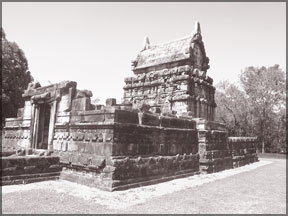Lotus of spiritual knowledge
By Richard Basnayake
Nalanda, a Monastic University is situated about 90 km, South East of
Patna, the capital of Bihar which translates as “ the place that confers
the lotus - of spiritual knowledge”.
This university flourished in this place from the 5th to the 9th
century AD. It is a flat land of lush green vegetation, which spreads
over an area of about 15 hectares, very quiet not polluted by empty
plastic mineral water bottles, and picnic hampers. It was known as
Nalanda Maha Vihara, which had eleven monasteries.
|

Nalanda Monastic University |
Lord Buddha’s, first disciples-chief disciples, Moggalana and
Sariputhra, were from the vicinity of Nalanda. It is recorded that Maha
Arahat Sariputhra, who had a very outstanding place in the “Sanga
Samajaya” attained the supreme Bliss of Nibbana here, and it was at this
site, Nalanda Maha Vihara was first established, during the reign of
Emperor Kumara Guptha; in the 5th century AD.
In the 9th century this great seat of learning reached its zenith of
fame. It is also recorded that great emissaries and eminent scholars
like Hiuen Tsang and his faithful disciple, Huwi Li, too have studied
here in the 6th and 7th centuries. The two scholar monks have left
behind detailed descriptions of this university.
Then language of discourse was Pali, Admission to this university was
highly coveted and only two students out of ten were admitted by the
“Dwar Panditha” a scholar, who screened the students at the university.
A Chinese scholar much referred to by historians, Hiuen Tsang, was a
student in the 6th century had learnt sanskrit under Rev, Dharmapala,
who was also the vice-chancellor of Nalanda University at the time. Rev.
Dharmapala was a Tamil by birth from Kanchipulam in the South and his
father was a Tamil King of Kanchipuram.
This university had a vast curriculum and all sorts of subjects were
taught. Medicine, Mathematics, Astrology, Agriculture, and even oratory
and debate (Vad-Vivad) too were included. It was considered that
debating was an essential part of this monastic education.
Lord Cunningham, the famous archaeologist did the first excavation in
1860s and it was revealed that, Nalanda Monastic University was built
three times over the same site. First it was built in the 5th century AD
then again in the 7th century and lastly in the 9th century, when this
great seat of learning reached its zenith of fame.
A huge fire schisms among various Buddhist sects and resurgence of
Hinduism brought the complete downfall of this monastic at the hands of
Muslim invader Baktiyar Kahlji in the 9th century AD.
The different stages of constructions in different periods, were
shown after the excavations done in 1860. This colossal complex built
using only dark red bricks in one huge labyrinth which extend over an
area of fifteen hectares of flat land. When the fire broke out the
fleeing Buddhist monks were able to carry away a few manuscripts from
the library which had nine million books.
In the well-kept small museum opposite Nalanda University, one can
see burnt - rice from the stores of the monastery, dark - black burnt -
bricks and other things the scholar monks used.
The largest stupa - Sariputhra Stupa built over his mortal remains,
can also be seen among the ruins. It is also recorded that this grand
red - brick Stupa is the highest in Nalanda. The stucco images of Lord
Buddha and Bhodhi Sathvas have been built into the stupa walls.
The three flight of steps which dominates the Northern end of the
Sariputhra Stupa are believed to be representative of three centuries,
namely 5th, 7th and 9th of constructions. The most remarkable one, built
outside belongs to the 9th century, the inner to the 7th century and the
inner most to the 5th century AD.
There were 10,000 student monks from all over the world and 2,000
university teachers to impart knowledge to them. Among the ruins of this
ancient Monastic University, one can see tiny cells or rooms with broad
varandahs, water-wells. community kitchens close by and large study
halls for student monks to air their views, and to debate about
discourses.
There were statues of Buddha at the entrance to each study halls, and
before entering these great halls the student monks had to chant
“Buddhan Saranam Gachchami.” The great Nalanda Monastic University is
one place which the archaeological authorities of India have kept clean,
beautiful and unpolluted. |
